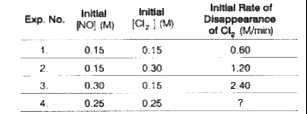A+2B→3C+2D
The rate of disappearance of B is 0.5×10−3mol L−1 s−1. What will be
rate of change in concentration of A and C?Solution in Odia
The correct Answer is:0.25×10−3 mol L−1 s−1,0.75×10−3 mol L−1 s−1
0.25×10−3 mol L−1 s−1,0.75×10−3 mol L−1 s−1
Topper's Solved these Questions
- CHEMICAL KINETICSBOOK - ARIHANT PUBLICATIONCHAPTER - CHEMICAL KINETICSEXERCISE - QUESTIONS FOR ASSESSMENT (Part I Rate of Chemical Reaction, Differential Rate Law and Rate Constant) Short Answer Type II Questions
4 Videos
- CHEMICAL KINETICSBOOK - ARIHANT PUBLICATIONCHAPTER - CHEMICAL KINETICSEXERCISE - QUESTIONS FOR PRACTICE (Part II Molecularity and Order of a Chemical Reaction) Multiple Choice Type Questions
2 Videos
- CHEMICAL KINETICSBOOK - ARIHANT PUBLICATIONCHAPTER - CHEMICAL KINETICSEXERCISE - QUESTIONS FOR ASSESSMENT (Part I Rate of Chemical Reaction, Differential Rate Law and Rate Constant) Very Short Answer Type Questions
3 Videos
- CARBOXYLIC ACIDS BOOK - ARIHANT PUBLICATIONCHAPTER - CARBOXYLIC ACIDS EXERCISE - CHAPTER PRACTICE (LONG ANSWER TYPE QUESTIONS)
3 Videos
- CHEMISTRY IN EVERYDAY LIFE BOOK - ARIHANT PUBLICATIONCHAPTER - CHEMISTRY IN EVERYDAY LIFE EXERCISE - CHAPTER PRACTICE (LONG ANSWER TYPE QUESTIONS)
2 Videos
Similar Questions
For the reaction,
2NO(g)+CI2(g)→2NOCI(g)
The following data were collected. All the measurements were taken at 263 K.

Write the expression for rate law.
View SolutionWhich one of the following statement for the order of a reaction is incorrect?
View SolutionDefine rate of reaction.
View SolutionConvert
(a) the benzoic acid to benzaldehyde
(b) the propanone to propane
View Solution(a) With the help of an example explain how do tranquilizers act as antidepressants?
View SolutionIn the reaction A+2B to 3C + 2D , the rate of disappearance of B is 1 xx 10^(-2) mol L^(-1)s^(-1) . What will be the rate of the reaction and rate of change in concentration of A and C?
View SolutionFor the elementary reaction 2A + B to 3C , if the rate of appearance of C at time 't' is 1.3 xx 10^(-4)mol L^(-1)s^(-1) , calculate at this time (i) rate of the reaction (ii) rate of disappearance of A.
View SolutionFor the reaction 2A+BrarrC , the rate of formation of C is 0.5 "mol" L^(-1)hr^(-1) . What is the rate of disappearance of A and b?
View Solutionअभिक्रिया A+2B→3C+2D में किसी क्षण D में किसी क्षण D की सांद्रता में होने वाले परिवर्तन की दर 0.4 mol L−1s−1 उस क्षण पर अभिक्रिया की दर, A तथा B विलुप्त (disappearance) होने की दर तथा C के बनने (appearance) की दर की गणना कीजिये।
View SolutionWhat would be the rate of disappearance of oxygen, if the rate of formation of nitric oxide (NO) is 3.6×10−3mol L−1s−1 ?
View SolutionIn the reaction,A+2B→3C+4D, the rate of disappearance of B at a given time is 10−2mol. L−1.s−1 Calculate
the rate of reaction
View SolutionA + 2B to 3C + 2D The rate of disappearance of B is 1xx 10^(–2) "mol L"^(–1) "sec"^(–1) . What will be (i) rate of reaction (ii) rate of change in the concentration of A and C ?
View SolutionFor an elementary reaction 2A+B to 3C the rate of appearance of C at time 't' is 1.3xx10^(-4)"mol L"^(-1)s^(-1) . Calculate at this time (i) rate of the reaction. (ii) rate of disappearance of A.
View SolutionFor an elementary reaction
2A+B→3C
the rate of disappearance of C at time t is 1.3×10−4mol L−1s−1. Calculate at this time
(i) rate of the reaction.
(ii) rate of disappearance of A.
View SolutionIn the reaction A + 2B rarr 3C + 2D , the rate of diappearance of B is 1xx10^-2 mol L^-1s^-1 . What will be the rate of the reaction and rate of change of concentration of A and C?
View Solution
